This entry will feature more pictures of Don that I took when he
was three and four months old during September and October. I took a ton
of photos of the little guy because he's so cute.In the last entry I
talked about the day we met Don on Southeastern Guide Dogs' campus south
of Tampa, FL. It was September 4, the day he turned three months old. We
brought him home the next day and he quickly became a part of our little
family of two people and now, three Labs. Puppy Don and Holly, age two,
quickly became best buddies. Even Casey, age seven, got playful at times.
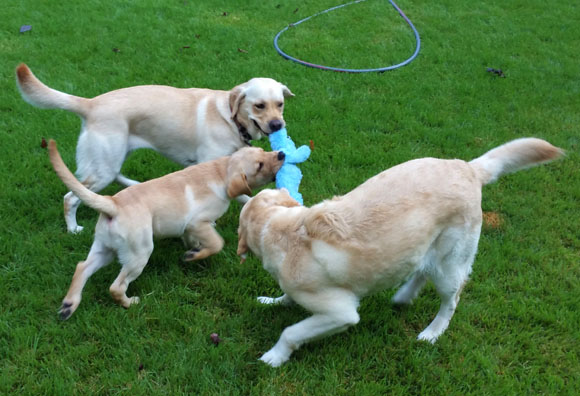
Holly (top), Don (middle), and
Casey share a stuffed toy. (9-7-19)
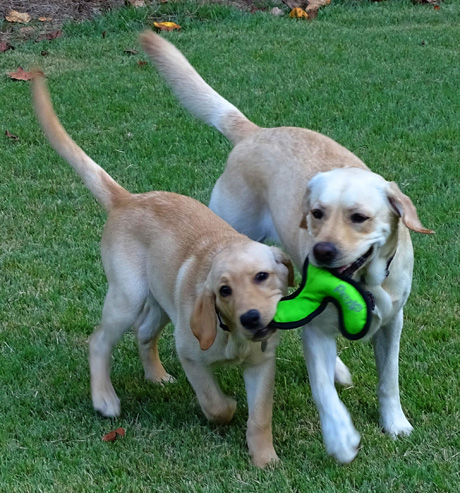
Don-Don (L) and Holly
(9-19-19)
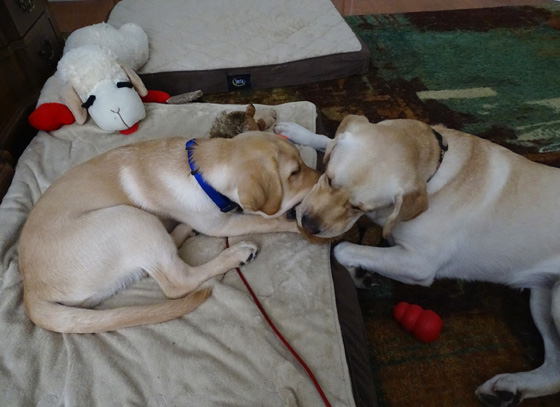
Lamb Chop was available to
supervise Don's and Holly's play, but no intervention was needed.
(9-7-19)
The text in this entry will focus on Don's early guide puppy training during
that period of time and how it differs from the previous training --
also reward-based and force-free -- that we did with our six pet Labs.
A WHOLE BIG MANUAL TO LEARN
Well, that's the first difference! We had just a few pages to
read when training any of our pet dogs.
After we expressed an interest in raising a guide puppy for Southeastern
Guide Dogs, we were directed to an important web link -- their latest
edition of a 132-page Puppy Raiser Manual dated July, 2019 -- and
encouraged to read all of it not once, but twice!
I can read fairly fast but trying to
remember all the details in this manual is impossible -- and
some of it has been updated since July. Revisions are continual. I've re-read parts of
it several times as they became relevant to new stages of Don's development.
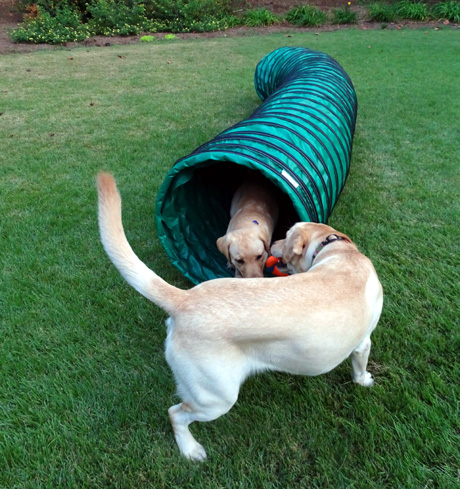
Don (inside tunnel) and Holly
playing with a rubber ring toy (9-14-19)
Topics
in the manual include what to expect from a puppy the first few days and
weeks it is in your home, what equipment and supplies to have, what
foods are permitted, what toys are allowed, how to safely transport a
puppy in a vehicle, how to housebreak, when to use a crate and
tie-downs, how to continue socialization and exposures to the real
world, how to handle all sorts of other issues -- and the stages
of training these puppies during the year, approximately, that the raisers have them.
We knew before applying to be puppy raisers that there would be some
different training protocols than we've used with our own pups over the
years even though they were also very positive, force-free, reward-based methods.
I had already talked to one of our Lab friends who has raised three guide pups for another
school, Guide Dog Foundation for the Blind, so that helped us understand some of what to expect.
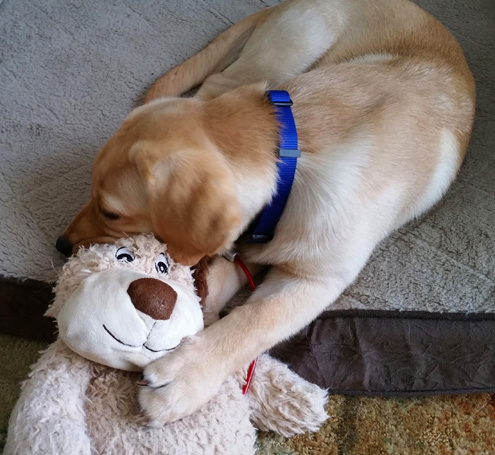
Don needs supervision with fabric toys and ones he can
chew pieces from,
and I have to remove the
squeakers in any toy he plays with. (9-16-19)
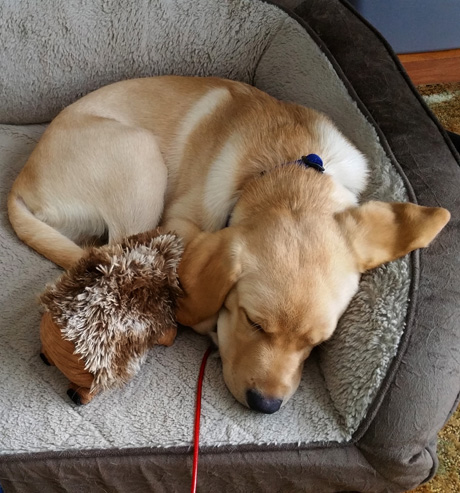
Don napping with a de-squeaked
hedgehog toy (9-24-19)
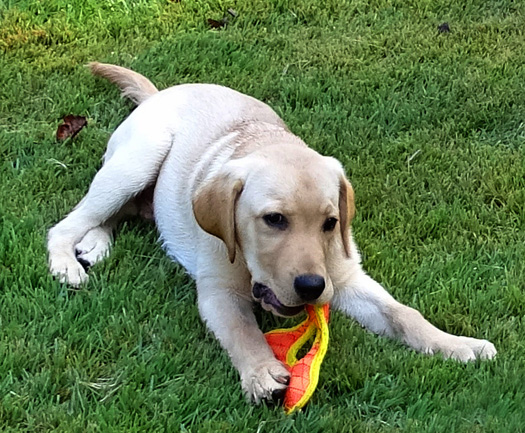
This ballistic fabric "boomerang"
is getting ratty but is still in play a year later!! Most other
toys except Kongs have long since
been destroyed by our two youngest power chewers. (9-20-19)
What I didn't realize was how different some of these guide training
techniques would be. I also underestimated how hard it would be for me to un-learn some of what
I'd learned previously from various dog trainers and re-learn some new commands and methods!
Fortunately, Don is an incredibly intelligent and adaptable puppy and
he has learned what he needs to learn in spite of any mistakes I've made
in the first four months he's been in our home.
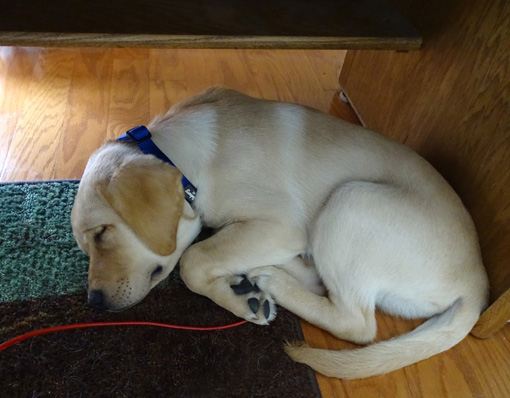
Above and below:
Don often peacefully sleeps under my desk or on the bed
nearby attached to a
3- or 4-foot "tie down," which keeps him close to me and out of
trouble. He's also trained to spend
some time during the day and night in one of his
crates. He settles quickly. (9-13 and 10-16-19)
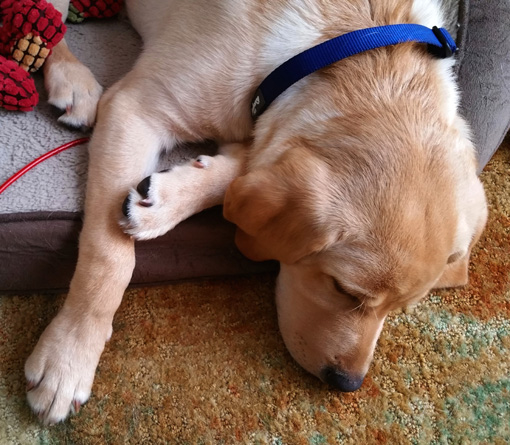
Some of the verbal and hand commands or cues are the same as those
we've used with all my Labs, such as sit, down, stand, stay, no, drop it, and
come. He already knew most of those when we got him, so they were all easy.
In fact, all I have to do is a high-pitched, happy "Don-Don"
and he's right there. He does know "Don, COME" as well. We got
mixed messages about the use of nicknames but make sure to use just his
name with a command and save nicknames for play.
Don's pretty much a Velcro
dog inside the house so I rarely need to call him to me there. That's
more important when he's preoccupied with something in the yard, like
chasing Holly or foraging in the grass and mulch. Obeying "come"
right away is the most critical of all commands for any dog to learn;
it could save their life sometime.
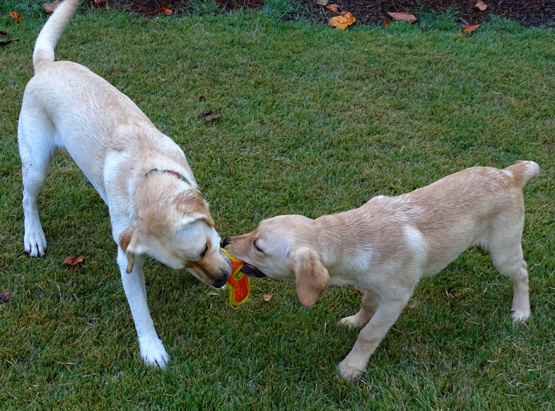
Playing "tug" is OK between Don
(R) and another dog
but not with people while he's in guide training. (9-20-19)
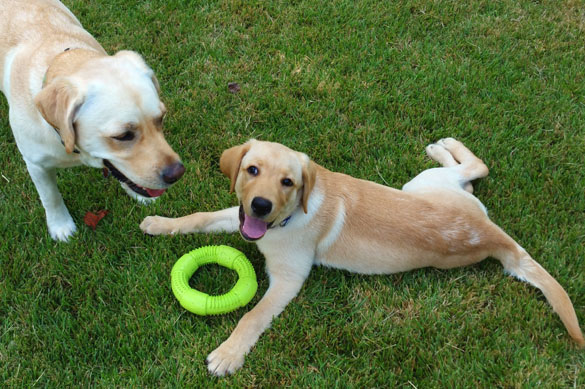
Tired, happy puppies! (9-14-19)
He also knew that a cheerful "YES!" as a marker word when he did as
requested earns him a treat. I just have to remember to say that first,
before I say "GOOD boy!"
I'm used to saying "good girl" with Casey and Holly. Don responds as well
to "good boy" as to "YES!" because it just pops into
my head automatically. Some other cues and techniques are new to us and those have been
more difficult for me to remember -- "place" instead of "go to
bed," for example, or "busy" instead of "go pee."
Don knows both, if I get it wrong.
PUPPY KINDERGARTEN
There are very detailed and continually-evolving steps that Southeastern wants raisers to
use when teaching critical concepts to pups in their earliest training.
Southeastern and other guide and service dog organizations
are constantly learning better techniques during all stages of training to improve their
rate of success in producing superior working dogs. The better equipped the pups are
when they go back for their advanced training, the easier that training is for the
pups and trainers.
Some of the techniques have already morphed a bit since we
got Don in September so it's a constant learning process for staff and volunteers.
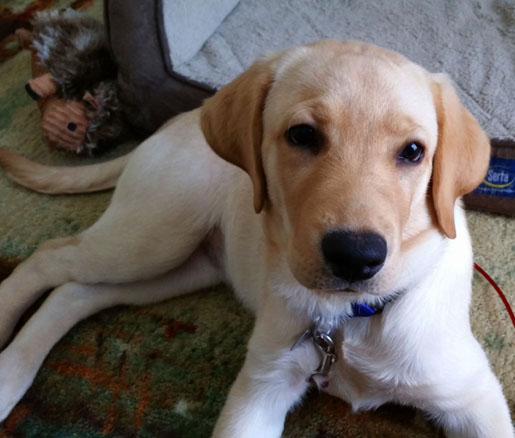
Don is so calm, intelligent, and
eager to learn and please that it's a joy to train him. (9-16-19)
Two basic concepts -- collar cues AKA collar pressure
and the use of paw pads -- are at the core of Puppy Kindergarten (PK),
the initial six weeks of training the pups receive once they
are in a starter home or with their raiser at two, three, or four months of age.
During this time raisers meet once a week for training with their Area Coordinator
(AC), the volunteer who heads their particular puppy raiser group,
or the Regional Manager (RM), who is the staff person who oversees several groups.

Don loves to lie on his back. It
looks like he's smiling in his sleep! (9-23-19 above and 10-22-19 below)
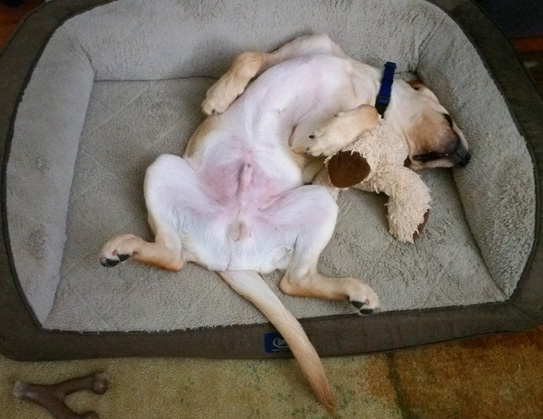
Our regional manager, Laura, used to live closer to campus in Florida. She moved to Georgia a
few months ago and manages several puppy raiser groups in five states, so she's often traveling.
I don't know how she handles all the puppies and people she is responsible for!
The good thing is, she lives within ten miles of us so she did our
home evaluation and all of Don's PK classes -- at our house, with just Don and us.
Our AC usually does PK classes with several young puppies together.
Both methods have advantages and disadvantages. Since our AC lives on
the other side of metro Atlanta, having the classes at our house not only
saved us six 100+-mile roundtrip drives across the city but Don also received one-on-one
professional training with Laura and we could ask her lots of questions. She is an awesome
trainer of people and puppies and was usually at our house for more than an hour each time.
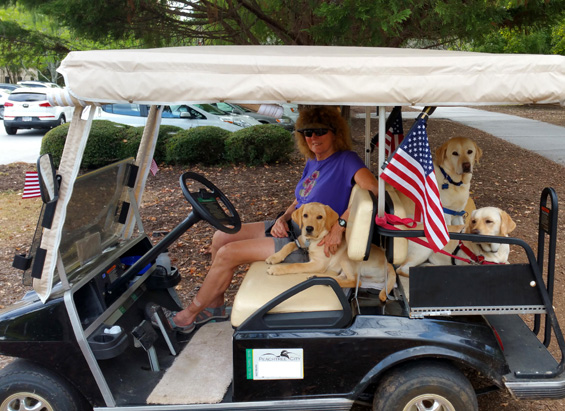
Don's been going on golf cart
rides with us around town since a couple days
after we got him. He's about 18
weeks old in these two photos. (9-27-19)
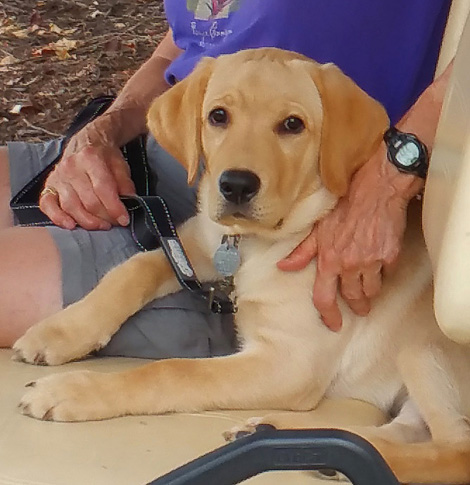
Since Don graduated from Puppy Kindergarten, however, we are required
to attend training sessions and outings twice a month north of Atlanta.
Most of the other puppy raisers live up that way, as well as our AC. Fortunately, the
meetings and outings are on Saturday mornings when traffic is a little lighter than
on weekdays or evenings.
As new puppy raiser applicants we had to attend
several training meetings and outings in north metro during July and August before
being approved to raise a puppy. That requirement helps new raisers know better
what they are getting into and the ACs can get to know them better.
Only a small percentage of potential puppy raisers actually become
puppy raisers because a lot of time and effort is required to
learn and do the job properly. It's even a bigger commitment than Jim and I
realized initially but we are determined to give Don the best possible
start toward a career as a guide or service dog.
COLLAR CUES: WHAT'S THAT?
I won't go into much detail about training collar cues except
to say that the techniques teach the puppies to follow the handler's
lead with gentle pressure on their collars before they learn the hand
and verbal signals for commands like heel, sit, down, "let's go,"
turning various directions, and backing up.
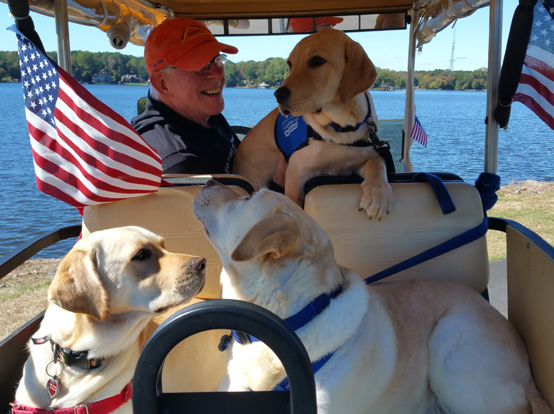
Another cart ride a month later
(10-27-19) when Don was getting closer to five months old
Collar cues are also the basis for pups learning to walk on a loose
leash with only a basic flat collar. SEGD does not allow the use
of halters and only allows the use of Infinity and Martingale collars
for the most energetic, independent pups that pull a lot.
Why? Because it's important later on during advanced training when the
older pups are in guide dog harnesses. They must learn to follow what the
blind handler's leash attached to their collar tells them to do. Fortunately
for us, Don is usually so calm and compliant that he has done fine with just a
flat collar.
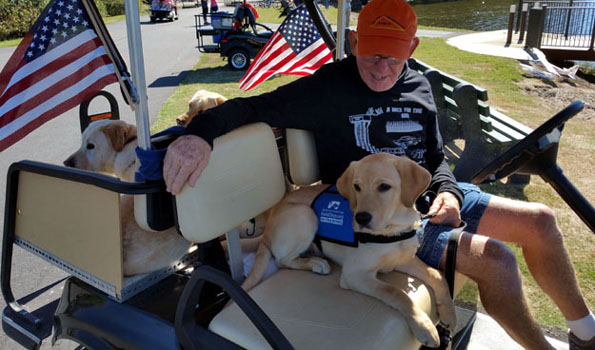
Three more photos from a cart
ride 10-27-19
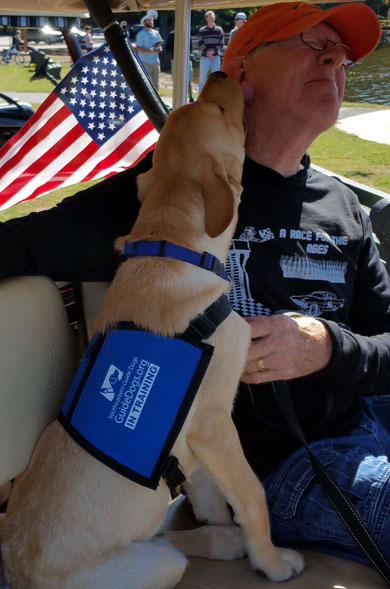
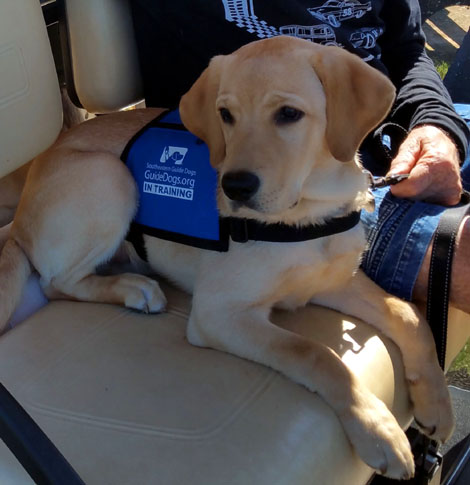
Walking on a loose leash without pulling is also important later on
for service dogs, especially if their handler is physically disabled.
About a third of SEGD's graduates become service dogs and two-thirds,
guide dogs. Warrior Canine Connection, which trains its pups to become service
dogs for disabled but sighted veterans, does use halters, Gentle
Leaders, or Infinity collars but they still
teach their puppies to walk on a loose leash with no pulling.
Since Southeastern Guide Dogs doesn't know in the first 15-16 months
which pups will qualify for the advanced guide training and which
will become service dogs or end up in other careers, all of the
puppies are required to learn collar cues at two to four
months of age.
PAW PADS: WHAT ARE THOSE?
The use of paw pads was another new concept for us and the puppies quickly learn to
love them! This was fun to teach Don.
The paw pads Southeastern uses are padded wooden blocks about 2"
high x 6" wide x 12" long that
help teach pups the proper position for the heel command. They quickly
learn to stand, sit, down, and "let's go" (move forward) from this
position on the left side of the handler.
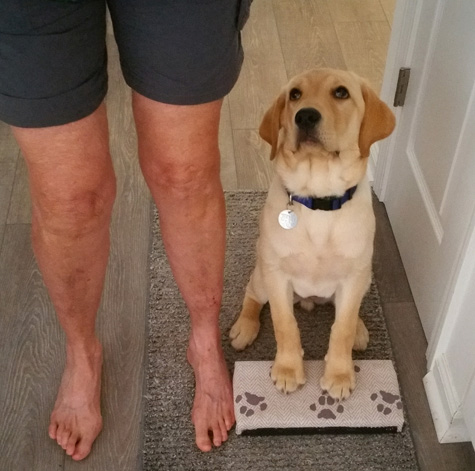
Don is very attentive while waiting for the "yes"
marker word
and treats for this perfect sit at the paw pad.
(9-20-19, 15 weeks old)
The reason the pups learn so fast on a paw pad is due to the
copious number of treats they get when they're first learning to use them!
Most Labs, including Don and all the pet Labs we've had, are highly motivated
by food rewards. That really helps with early reward-based training.
Southeastern encourages raisers to use kibble from their daily food
allotment as treats and to save any high-value treats until they are
five or six months old.
Since the pups are getting these "treats" from their regular food,
the initial training on the paw pad is to reward them with about ten
pieces of kibble in rapid succession called "Pezzing" when one or
two paws are on the paw pad correctly for each command.
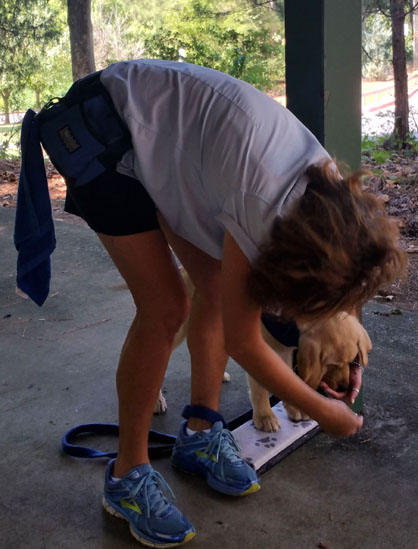
Laura shows us how to "Pez" Don
with kibble treats during our first
paw pad lesson two days after we
brought him home. (9-8-19)
Believe me, puppies will learn real fast to get into position correctly when
they get that much food, especially if it's part of their breakfast
allotment and they are still hungry!
The kibble reward is gradually decreased as they learn the commands on the
paw pad.
Even though raisers don't need to use paw pads to teach these
concepts after a few weeks, they can be used later to reinforce cues
pups might "forget" when they are adolescents or need in a high-stress
situation when it's difficult for them to focus on their handler. Some
raisers use them during outings but Don was so compliant he heeled well
without a paw pad in other locations.
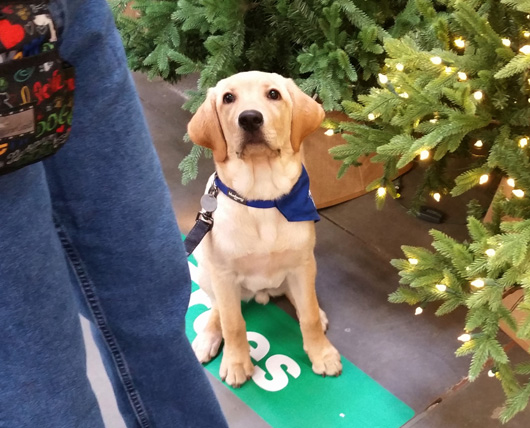
In retrospect, I wonder if Don
thought this was a paw pad! (on a visit to Home Depot)
Don still loves his paw pad so much at six months of age that I
occasionally use it in training simply because I like to see him so
happy. He just lights up when I reach for the paw pad or move the little
kitchen rug that I put under it for traction when he's on a slick floor.
He has a very positive association with both the rug and the pad (= treats!!).
It's really cute to watch his reaction. And he's still quite happy with
just one piece of his kibble or verbal praise for obeying the cues. I'm just
starting to use higher value treats like Zuke's with him at six months of age.
LOOSE-LEASH WALKING
I've already mentioned the concept of loose-leash walking. Raisers
start working on this as soon as they get their pups at ten weeks or older.
When Don came to us at 13 weeks of age it was obvious that he'd had
some leash training on campus already. We still worked daily on proper
walking technique in the house and our yard the first couple weeks, then
in our neighborhood and other public places after he got all his shots
at 16 weeks..
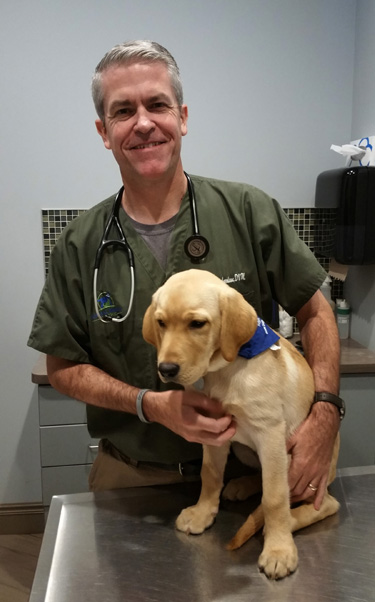
Our awesome vet, Dr.
Jeff, with Don at 16 weeks (9-23-19)
Collar cue training was never as much fun as paw pad training but Don does
pretty well with loose-leash walking on residential streets, on
dirt trails, in shopping areas, and in
stores because of all the collar-cue work we did when he was little
and continual use of it now that's he's bigger and stronger.
When he wants to sniff a mailbox or something interesting I tell him
firmly "no" or "let's go," encouraging him forward with collar cues,
praise, and/or a piece of kibble.
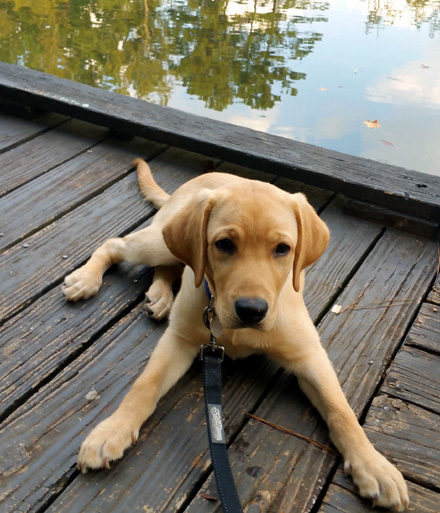
On the pier at Line Creek Nature
Area; Don had just turned 4 mos. old. (10-5-19)
Don is much more distracted by dog and other animal scents on
Peachtree City's extensive network of paved multi-use paths than
residential streets or other places where I walk him. A lot of dogs use the paths
because they are convenient and safe. We use the paths almost
every day with Don and our own two Labs. He does better on trails, even
though there are other types of enticing scents there.
Walks on the paths just take longer as I redirect Don's focus
after letting him "break" occasionally to sniff something. He needs that mental
stimulation AKA enrichment, too, as he learns about his world. As he
gets older he's expected to continue walking more and sniffing less.
IMPULSE CONTROL & DISTRACTIONS
Which brings up teaching the young pups to avoid distractions and focus on
their handlers in general . . . another concept critical in guide puppy
training.
Just visualize how important it is for a guide dog to ignore all the
scents, sounds, and sights around him as he's navigating with a totally
blind person along a busy sidewalk or road or past a city park with dogs and
little kids playing.
He can't just stop to watch or, worse yet, run
toward something that interests him!
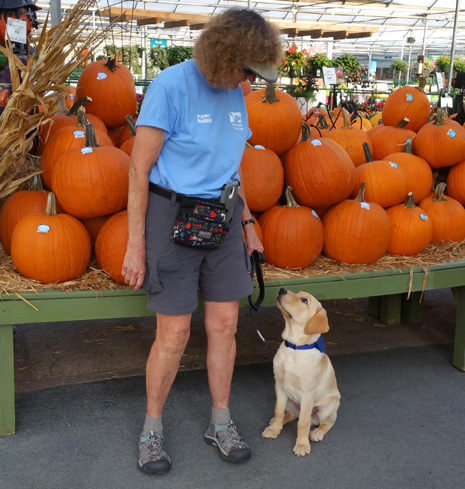
Above and below: Great focus on Mom at Pike
Nursery at not quite 4 mos. old!
This is a quiet, partly-outdoors
business, a good place for early outings.
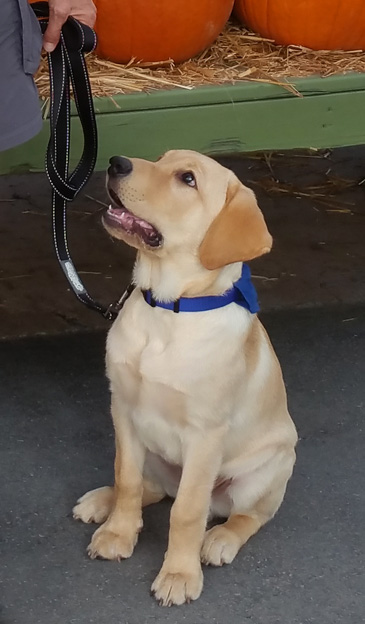
Ignoring distractions was one of the things we began to teach Don in
Puppy Kindergarten. He learned to focus on me instead of treats right in
front of him on the floor, a favorite toy nearby, or a ball rolling past.
Fortunately, Don has pretty good impulse control for a Lab puppy.
He's always been noticeably more laid back than our two Lab girls, more like Cody was,
and he's noticeably more laid back than the other pups (most of them
older) in our puppy raiser group.
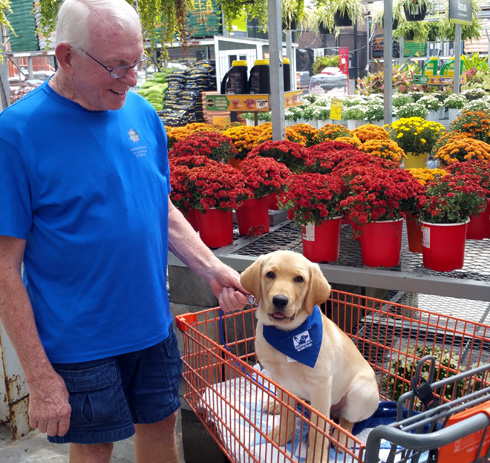
Above and below: Don's
first trip inside Home Depot
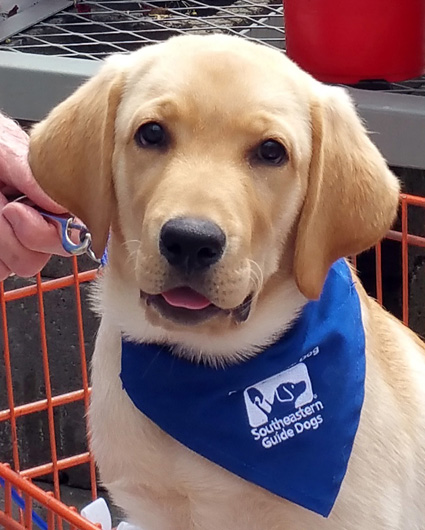
Don notices things that would stimulate a more impulsive puppy or dog
but he doesn't bark, pull toward them, or show much reaction except
maybe to stop and watch for a little bit. Although he wants to say hi to
every dog he sees he is not distracted by all the wildlife in our yard
and beyond, including rabbits, deer, ducks and geese, other birds, and
at least a gazillion squirrels in Peachtree City.
That's definitely a very good trait for a future guide or service dog
to have. And as he gets older he is learning to ignore people and
other dogs, too, unless given the OK to greet them.
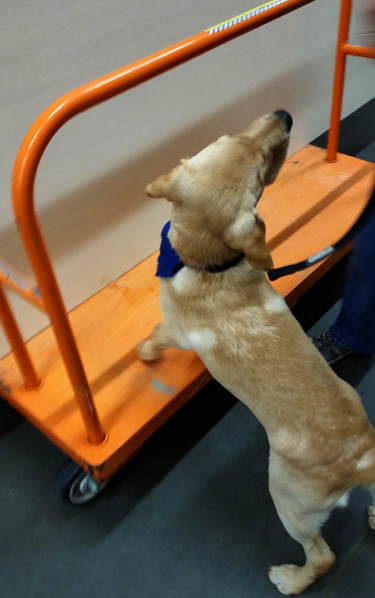
A trip to Home Depot at 4 mos.
old to practice impulse control
and different footings, such as this cart that
moves

A couple weeks later Don told Santa he's been a
Very Good Boy,
and Mom wholeheartedly vouched for him.
When Don was still quite young we taught him a fun
impulse control game we play with our girls. We put treats on
their paws or in front of them -- sometimes spelling their names
-- and instruct them to "leave it" for up to a minute, then
let them "take it."
Don picked this up very quickly at only three months of age but we use
the SEGD-approved cues of "wait" and "break" with him.
I know WCC puppy parents do this with their pups a lot, too. It's an easy,
effective way to teach any puppy or older dog impulse control.
GRADUATION FROM PUPPY KINDERGARTEN
At the end of Don's six weeks of early training sessions in our home
we met Laura, our regional manager, at the local Pike Nursery so she
could evaluate his progress and determine if he was ready for the next
stage of training with the older pups in our group. He was a little over
four months old when he "graduated" on October 15.
Laura brought a cute little graduation hat for the occasion. After we
put Don through his paces we met outside the front door where the
nursery had a nice fall display with hay bales, pumpkins, and mums to take pictures.
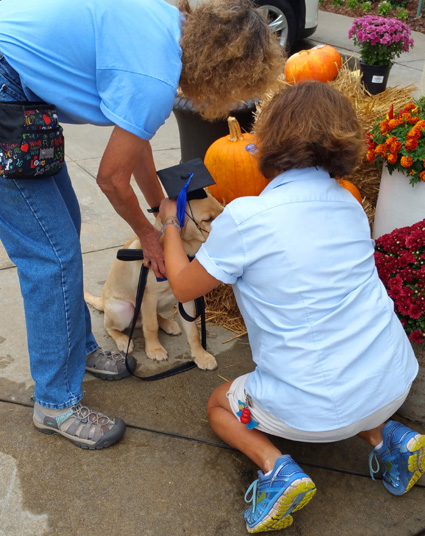
Laura (kneeling) adjusts her
little graduation cap on Don for the umpteenth time.
In hindsight, I should have better prepared Don for wearing something on his head!
I have to give Don, Jim, and Laura a lot of credit for their patience
during this photo shoot. Don did NOT like the cap on his head. Although
he sat well, he kept moving his head and the cap repeatedly
fell off, even though there was an elastic band under his chin. Jim took
a whopping 58 pictures so I had some decent ones to choose for this journal and Facebook.
You can see how Don felt about the whole situation in the next
picture! (The "out-takes" are pretty funny.)
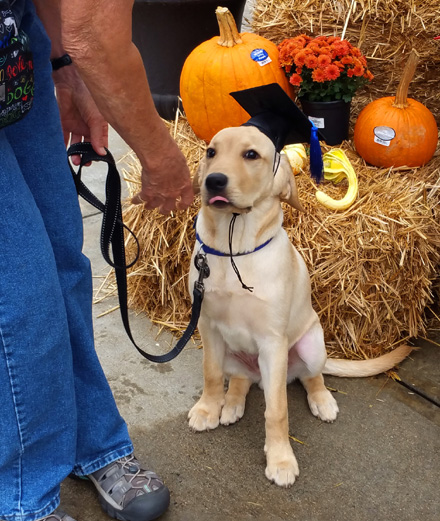
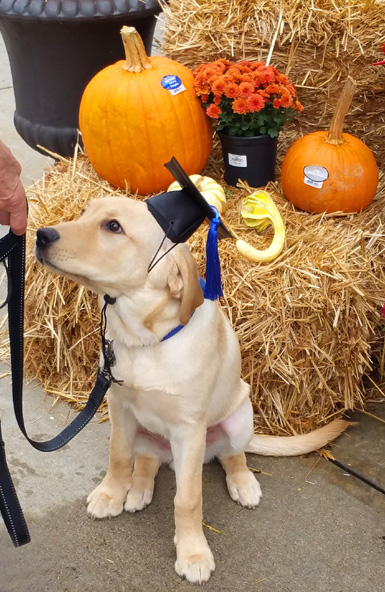
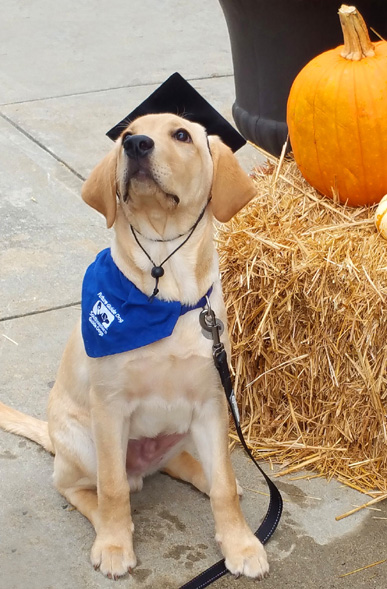
We were nervous about how Don would do with the evaluation.
That was a breeze compared to the photo shoot afterwards!
We were thrilled that Don "earned his coat." We got it from our
area coordinator when we took Don to his first meeting with our puppy group.
You can see it in some of the photos from late October in this entry.
Next entry: Don's guide training and activities during
November and December (age five and six months)
Happy trails,
Sue
"Runtrails & Company" - Sue Norwood, Jim O'Neil,
Casey-Girl, and Holly-Pup
Previous
Next
© 2019 Sue Norwood and Jim O'Neil